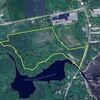Processing Your Payment
Please do not leave this page until complete. This can take a few moments.
Born to be wild | A controversial court case, a rift between Maine and Canadian growers and a lous harvest. Who says the wild blueberry industry's in trouble?
A stunted harvest is the most recent bane of the state's $75 million to $100 million-a-year blueberry business, 70% of which is located in Washington County. Estimates predict a loss of 25 million pounds or so of berries this year, for a total crop about a third smaller than last year.
The problem began quietly in mid-winter, beyond headlines focused on the Knox County courtroom where small blueberry growers and large grower-processors battled over a price-fixing lawsuit. At about the same time, a rift between Maine and Canadian berry interests was being formalized, with the parties agreeing, in marketing terms, to go their separate ways.
Outside in the fields, little snow fell, leaving Maine's 65,000 acres of low bush blueberry plants exposed to sub-zero temperatures. When the freeze killed the plants' blossom-bearing upper branches, and then a drizzly spring kept honey bees from pollinating what remained, the 2004 blueberry crop was devastated.
There is an upside to the situation, according to David Yarborough, blueberry specialist with the University of Maine's cooperative extension: No fruit this year means the plants should flourish, potentially delivering a much larger harvest next year. "As far as this year, it's a loss," Yarborough said. "As far as the future, it's a positive."
Yarborough's forecast sums up views held across the entire wild blueberry industry. Despite this year's setbacks ˆ the contentious court case, the split of the Wild Blueberry Association of North America, the severely hobbled berry crop ˆ industry experts feel a terse optimism that the next few years promise increasing success.
In overview, the industry's track record supports such hope. Over the past 20 years, annual blueberry harvests in Maine have grown from 20 million to 80 million pounds, and to nearly twice that on the Canadian side. (Maine and Canada produce the entire North American wild, or low bush, blueberry crop.) The industry has managed to capture and hold the international trade ingredient market, in which wild blueberries become ingredients in muffins, pie fillings, yogurt and other products. And, most recently, research detailing the health benefits of blueberries has opened the door to an increasing number of retail opportunities.
"This industry should be enjoying the best of times," said Ed Flanagan, president and chief executive of Milbridge-based Jasper Wyman & Son, one of the industry's largest grower-processors. "But it has, in fact, been the worst of times."
Blue period
The industry in Maine and Canada entered its blue period five years ago, when improved farming practices and a favorable season combined to produce a branch-bending harvest, particularly for growers in Quebec. Awash in unsold berries and facing a weak exchange rate, Canadian processors dropped their prices and dumped berries where they could.
"They were selling, to some extent, in the U.S. for Canadian dollars," said Peter Rideout, a marketing specialist with the Nova Scotia Department of Agriculture and Fisheries. "And I don't think anybody made any money for a while there."
Prior to the glut, wild blueberry growers enjoyed a 10- to 15-cent-per-pound premium over their counterparts elsewhere in the United States selling cultivated, or high bush, berries to trade ingredient markets. But in the wake of the Canadian oversupply, prices to growers in Maine dropped from near 50 cents to less than 30 cents per pound.
In addition to the price pressure felt by Maine growers, they and their Canadian counterparts have been suffering from increasing competition from cultivated berries. In 2003, for example, Maine and Canada produced more than 200 million pounds of wild blueberries, while 11 American states yielded 190 million pounds of cultivated berries ˆ and that figure doesn't include the cultivated berries grown in California, which has a young, fast-growing blueberry industry that Yarborough says will produce nearly six million pounds this year.
Despite the increasing supply from high bush growers, and their continuing attempts to gain an increasing share of the trade ingredient market, prices for Maine growers have recovered slightly; growers this year are receiving between 30 and 40 cents a pound.
Last year, though, Flanagan of Jasper Wyman & Son held the Canadian berries responsible for the loss of the wild berry premium, and began to pursue potential trade tariffs on Canadian blueberries. He and other Maine growers also were miffed that Canadian growers were benefiting from WBANA marketing efforts funded largely by U.S. producers, and U.S. Department of Agriculture research funded by American tax dollars. For their part, Canadians, who sell the vast majority of their berries in overseas markets, felt shortchanged by WBANA's emphasis on U.S. markets.
Growers on both sides of the border eventually agreed on pricing standards, and on a plan to divide their marketing efforts, which would strengthen WBANA's existing Canadian division. Flanagan dropped his tariff threat late last year, and U.S. processors turned to face a lawsuit filed by a small group of growers, alleging processors had conspired during prior years to hold down prices paid to berry farmers. (See "A tangled web," p. 23.)
In the midst of all the debate was John Sauve, a marketing pro who answers any question about the blueberry industry in Maine with a corrective response that begins, "The wild blueberry industry." After 11 years as executive director of WBANA, he is an inexhaustible font of berry lore. Since the mid-1990s, his language has become increasingly laced with technical terms like antioxidant, neutraceutical and anthocyanin ˆ research-speak issuing from the growing body of evidence suggesting blueberries may be elbowing their way up the health food chain. Antioxidants, disease-fighting compounds believed by many scientists to prevent damage to human cells, are fast becoming an important measure of a blueberry's value on health food markets. A USDA report on fruits, vegetables, berries and nuts containing antioxidants ranked wild blueberries number two, and cultivated blueberries number four.
Sauve's goal: to push such blueberry-friendly research and language further into popular dialogue and "to truly change the image of the wild blueberry from just something in a muffin to a health icon."
All sides agree the mounting research has been a significant boon to the blueberry business. One gauge of the blue fruit's newly healthful image is the Japanese market. In 1995, wild blueberries had been available in Japan for 20 years; sales typically hit three million to five million pounds per year. This year, Sauve reports Maine and Canada will export 50 million pounds to the land of the rising sun. "The Japanese are highly sensitive to a health story, especially to a nutraceutical story that is grounded in science," Sauve said, referring to foods with enhanced vitamin properties. "Our product captured some of that."
The wild distinction
But holding that high ground could prove difficult. Sauve is committed to driving a wedge between the images of wild and cultivated blueberries. His focus, particularly since WBANA divided the bulk of its U.S. and Canadian marketing strategies, will be on the American and Japanese markets. The wild blueberry's reputation as a "health icon," Sauve contends, would assure Maine berry growers consistent demand and premium prices.
But many in the industry feel such language too complex, the wild-versus-cultivated distinction too fine to make to the average consumer. John Bragg, president of Nova Scotia-based Oxford Foods Group, which also owns Cherryfield Foods and Maine Wild Blueberry in Machias, believes what is good for cultivated is good for wild, and an increasing awareness of blueberry benefits will inevitably raise interest in the entire industry.
"A blueberry's a blueberry," said Bragg, who manages more than 10,000 blueberry acres in Maine and an equal amount in Nova Scotia. "I'm not critical of those who think we should [push to distinguish Maine and Canadian berries as wild] but can you imagine how many millions of dollars Coors Light has spent to distinguish their light beer from Bud Light? And does the average consumer know the difference? Most don't."
Flanagan, on the other hand, says if Maine growers and processors are to prosper, it's critical to differentiate the wild from the cultivated crop. "John Sauve has done magnificent work," Flanagan said. "But when he does a wonderful job of informing people about the benefits of eating blueberries, a lot of times the only blueberries available are cultivated."
To continue its growth ˆ some estimates say Maine could potentially double or triple its current harvest without expanding its acreage ˆ the wild industry is reaching beyond its traditional markets. Wyman, which recently edged above $40 million in annual revenues, has set its sights on retail and food service markets. Ten years ago, the company relied solely on blueberries sold to the ingredients market. Today, blueberries account for less than two-thirds of sales, alongside strawberries and raspberries. Wyman does substantial business selling frozen fruit to operators including North Center Food Service and Sysco Food Service.
Sauve and Flanagan agree the potential for those channels has only just been scratched. With their long harvest season and fat berries, cultivated blues are hard to beat on the fresh market. Smaller wild berries, on the other hand, deliver more bits of blue per muffin, pancake or yogurt package, an inherently attractive trait to the ingredients trade. "The piece count you get with wild blueberries per pound ˆ that alone provides an advantage in the baking industry," Rideout said. Wyman, in hot pursuit, has scaled up its frozen berry packaging and developed a line of fruit juices in addition to its old standby, canned blueberries.
Retail channels also hold benefits for much smaller growers. Sanford Kelly, a former blueberry commissioner who farms 50 acres of blueberries in Jonesport, is one of 25 growers who make up the Sunrise County Wild Blueberry Association. The association produces the Maine Select berry brand, delivered frozen, with the bloom on, packaged in clear, clamshell boxes. It sells to retailers including Hannaford, Shaw's and Associated Grocers of Maine for just over $21 per dozen pints. "We had to put a moratorium on membership, because our production was getting ahead of our demand," Kelly said. "The co-op did 288,000 pints last year."
Demand aside, Bragg of Oxford Foods said some of the most pressing matters in the blueberry business ˆ Canadian or American ˆ revert to basic issues of agriculture: nurturing more productive crop land and moving toward more modern and competitive practices. Realize those efficiencies and grow more berries, Bragg argues, invest to sell the health benefits of all blueberries ˆ cultivated and wild ˆ and consumers will eat it up. "The more people eat fresh blueberries, the more they'll eat processed blueberries," he said. "We can either be threatened by [the cultivated berry growers] or say they do a good job for us."










Comments